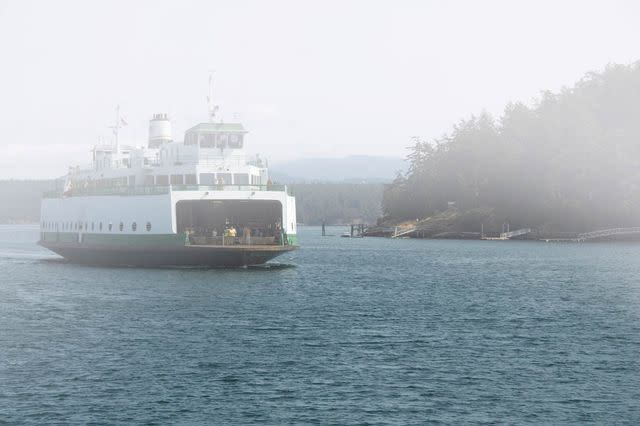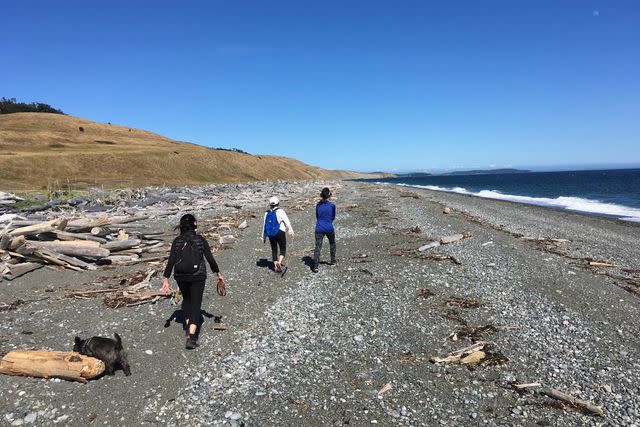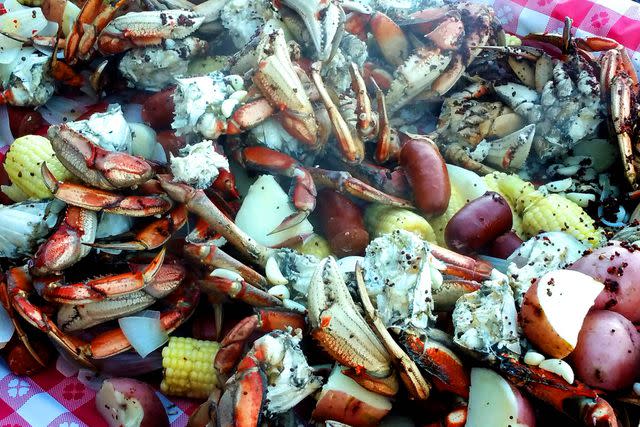This Wildly Scenic Island in Washington State Has Rocky Beaches, Great Seafood, and Beautiful Coastal Trails
How a Washington local does San Juan Island.
I’m always amazed how many people have never heard of the San Juan Islands. Tucked away in the upper corner of the Pacific Northwest, just a stone’s throw from Canada, the archipelago is home to some of the most serene landscapes I’ve seen. There are several islands worth visiting, but the go-to for my family is the second largest: San Juan Island. In the same day, you can watch waves violently collide with craggy, windswept shores, hike through the woods, stroll through a lavender field, and sit down to a farm-to-table dinner.
To get there, you can take a short flight on a small aircraft, but most people drive, bike, or walk onto the ferry in Anacortes, about 1.5 hours north of Seattle. On the ferry, you can grab a coffee from the café inside or spend time on the deck, feeling the clean, salty air whip about and taking in the expansive view of forested islands dotting the sea.

Getty Images
Equally appealing is that you don’t have to be super outdoorsy or athletic (I’m neither) to enjoy the natural landscape, which is shared by deer, foxes, and hundreds of species of birds. Look closely, and you might be lucky enough to spot a bald eagle soaring overhead, or the slow arc of an orca cresting the waves. In 2013, President Obama designated the region as a national monument, and visiting comes with a responsibility to respect the land.
The ferry stops in Friday Harbor, a charming, walkable, and boutique-littered district of the island. You can park right when you get off the ferry and stroll up the main street, which is flanked by galleries, independently owned shops, and eateries. I love to catch the Saturday morning farmers market (active from April and October) to grab pastries and listen to live acoustic music.

Annie Midori Atherton
I’m decidedly not a biker — doing so in a big city terrifies me — but I make an exception for the long, smooth roads of the San Juan Islands Scenic Byway, which circles the island. If you don’t have a bike, you can rent one or take a guided tour. I haven’t attempted the entire circumference, but just going a few miles from False Bay to Cattle Point takes you past open fields, bucolic farms, and rocky beaches. While the steep hills push the limits of my calf muscles, the promise of panoramic vistas at the top keeps me going. There’s one spot where you come up a staggeringly high slope and can suddenly see the ocean on all sides, as far as the eye can see. I never remember exactly when it’s coming, and that’s half the reward.
Many easy-to-moderate trails, such as the 3.6-mile Mount Finlayson loop, offer a quieter way to take in the forests and access viewpoints. More walking routes can be found in Lime Kiln Point State Park, named after the crumbling 19th-century kilns on its grounds. The park’s several meandering trails invite you to take your time exploring. On one hike, we spotted a fluffy brown owl nestled into a tree just feet away from the trail. Before leaving, check out the century-old lighthouse, located about 300 yards from the parking lot. I’ve also spotted a few whales from this spot (and viewing them from the land is less disruptive than by boat). Get there at sunset, and you can see a rose-pink sky wash over layers of low clouds.
Of course, the most up-close view of the water is from its surface. We’ve rented kayaks, which is nice because you can set your own pace, but there are also numerous guided kayaking and paddleboarding tours for those who prefer to paddle with a professional.
The island’s low-key vibe belies top-tier dining options, many of which operate in cozy craftsman houses and other modest spaces, but you can tailor your stay to be as luxurious or casual as you like. In addition to the farmers market, we have a tradition of stopping at Bakery San Juan after we first arrive for fresh loaves and treats.
Many San Juan Island restaurants source seafood from local purveyors such as Westcott Bay Shellfish, which is a worthwhile destination in its own right. We went there at the height of the pandemic, knowing they have picnic tables outside facing the shore. Before sitting down to lunch, we took a walk down the dock and peered at the workers tending the oyster farms right on the beach. (It felt like we were watching a food documentary.) Back at our table, we slurped down a half dozen crisp, clean oysters — raw and grilled — along with a glass of white wine, and it was probably the most relaxed I’d felt in months.
For an upscale dinner, the menu at Coho Restaurant showcases local ingredients like sweet onion, heirloom carrots, and mussels caught right on the island. Nearby restaurant Duck Soup, which has been going strong for more than four decades, also centers on local ingredients, complete with cocktails with wildflower garnishes fit for a fairy tale. For lighter fare, Everelse tasting lounge and wine bar offers artisan cheeses and meats, which guests can enjoy in the sunny wine garden.
Elsewhere on the island, we always make at least one stop at Roche Harbor, where an elegant hotel in a 19th-century building with white wraparound balconies provides the backdrop for a shopping center and yacht-filled marina. Many couples choose it as their wedding destination (it’s ranked in The Knot’s “Best of Weddings” hall of fame) for good reason.

Timothy Scheibe/EyeEm/Getty Images
The harbor also holds several memorable restaurants. One afternoon, we enjoyed a filling lunch of fish and chips and light beer on the sunny deck at Madrona Bar & Grill, which overlooks the water. For something more upscale, McMillin’s Dining Room provides a traditional fine-dining experience, with an extensive wine list and “10-hour roasted prime rib,” as the menu promises, on weekends. During evenings in the summer, guests are treated to a “colors ceremony,” where a cannon is shot over the harbor just before sunset.
As with food options, when it comes to accommodations, you can really choose your own adventure, from upscale hotels like Roche Harbor Resort, to Airbnbs and Vrbos, to camping and glamping (a friend of mine raved about renting a yurt at Lakedale). Many of the resorts also have multi-bedroom houses for group getaways. If you really want to dig into outdoor recreation, I love the grounds at the rustic Snug Harbor Resort, which gives guests access to complimentary on-site kayaks, canoes, paddleboards, and bikes.
Guests who want to cook a fresh seafood meal on the spot can enjoy a beachside fire pit, a grill, and crab cookers. I have fond memories of going out on my uncle’s fishing boat, which he docked at the marina, into the protected bay to harvest crab. Wherever you stay, you won’t be far from either town or the trails, though it is definitely a good place to have a car.
No matter how many times I’ve returned to San Juan Island, there are still moments that surprise me. The last time we were there, we ventured out to Grandma’s Cove, a small, horseshoe-shaped pocket of shoreline. We had the beach to ourselves, and at that particular moment in the afternoon, the sun sparkled off the waves, which stirred wildly within the cove. I have a video of it on my phone, but it doesn’t come close to the feeling of being there. I hope someday I can catch the cove again in the exact same light, but I probably won’t. The weather changes as quickly as the waves recede. Either way, I know I’ll see something unexpected.
For more Travel & Leisure news, make sure to sign up for our newsletter!
Read the original article on Travel & Leisure.

